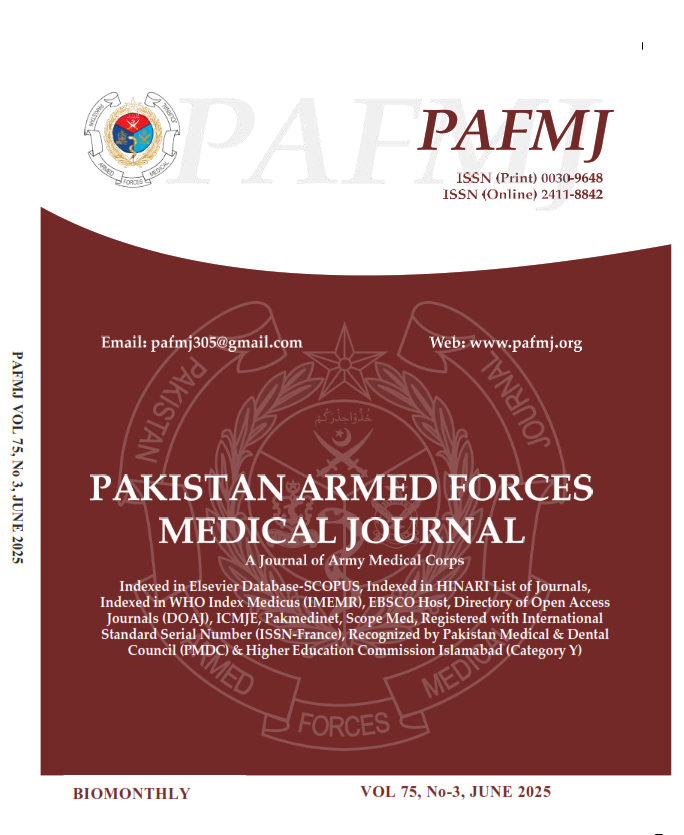Frequency of Hypoglycemia in Neonates with Intrauterine Growth Restriction Presenting to Pak-Emirates Military Hospital Neonatal Intensive Care Uni
DOI:
https://doi.org/10.51253/pafmj.v75i3.10179Keywords:
Hypoglycaemia, Intrauterine Growth Restriction, Neonates.Abstract
Objectives: To determine the frequency of hypoglycemia in neonates born with intra-uterine growth restriction.
Study Design: Cross-sectional study.
Place and Duration of Study: Department of Paediatrics, Pak-Emirates Military Hospital, Rawalpindi, Jan to Sep 2022.
Methodology: This study was conducted on 127 neonates diagnosed with intrauterine growth restriction. Neonates with IUGR who were born at term were included in the study. Those born to diabetic mothers, with chronic disorders, or were born with birth asphyxia or meconium aspiration were excluded. Neonates were tested for blood glucose levels at birth and then at hourly intervals for five hours post-birth.
Results: We studied a sample with a mean gestational age at birth of 38.56±1.48, of whom 72(56.7%) were female. The sample had the lowest mean blood glucose levels at three- and four hours after birth. A total of 52(40.9%) neonates developed hypoglycemia at least once during the five-hour observation period. Neonates who were delivered via cesarean section had a significantly lower frequency of development of hypoglycemia compared to those delivered per vaginum (p=0.012). Other factors such as neonatal gender, gestational age at birth, maternal history of smoke exposure, abortions or previous neonatal death, and antenatal care receipt were not associated with an increase in the frequency of hypoglycemia (p>0.05).
Conclusion: Hypoglycaemia is common in neonates suffering from intrauterine growth retardation and requires adequate monitoring in this population.
Downloads
References
Tesfa D, Tadege M, Digssie A, Abebaw S. Intrauterine growth restriction and its associated factors in South Gondar zone hospitals, Northwest Ethiopia, 2019. Arch Public Health 2020; 78(1): 89.
https://doi.org/10.1186/s13690-020-00475-2
Armengaud JB, Yzydorczyk C, Siddeek B, Peyter AC, Simeoni U. Intrauterine growth restriction: Clinical consequences on health and disease at adulthood. Reprod Toxicol 2021; 99(1): 168-176.
http://doi.org/10.1016/j.reprotox.2020.10.005
Chew LC, Verma RP. Fetal Growth Restriction. In: StatPearls. Treasure Island (FL): StatPearls Publishing; 2022.
Hu J, Benny P, Wang M, Ma Y, Lambertini L, Peter I, et al. Intrauterine Growth Restriction Is Associated with Unique Features of the Reproductive Microbiome. Reprod Sci 2021; 28(3): 828-837.
http://doi.org/10.1007/s43032-020-00374-5
Mense L, Birdir C, Reichert J, Schleußner E, Proquitté H, Schmitt J, et al. Intrauterine Growth Restriction: Transsectoral, Inter-disciplinary and Multiprofessional Care for Pregnant Women and Newborns in a Feto-neonatal Pathway: A Project of the Innovationsfonds. Z Geburtshilfe Neonatol 2020; 224(1): 15-21.
http://doi.org/10.1055/a-0998-4532
Abramowski A, Ward R, Hamdan AH. Neonatal Hypoglycemia. In: StatPearls. Treasure Island (FL): StatPearls Publishing; 2022.
Edwards T, Harding JE. Clinical Aspects of Neonatal Hypoglycemia: A Mini Review. Front Pediatr 2021; 8(1): 562251.
http://doi.org/10.3389/fped.2020.562251
van Kempen AA, Eskes PF, Nuytemans DH, van der Lee JH, Dijksman LM, van Veenendaal NR, et al; HypoEXIT Study Group. Lower versus Traditional Treatment Threshold for Neonatal Hypoglycemia. N Engl J Med 2020; 382(6): 534-544.
http://doi.org/10.1056/NEJMoa1905593
Taranushenko TE, Kiseleva NG, Lazareva OV, Kalygnaja II. Hypoglycemia in neonates: a review of the literature and a case report. Probl Endokrinol 2019; 65(4): 251-262.
http://doi.org/10.14341/probl8336
Austie FM, van Unen HJ, Smit-Wu MN, Bekhof J. Oral glucose in neonates with an increased risk of neonatal hypoglycaemia halves the number of neonates receiving intravenous glucose. Ned Tijdschr Geneeskd 2021; 165(1): D5466.
Doctor BA, O'Riordan MA, Kirchner HL, Shah D, Hack M. Perinatal correlates and neonatal outcomes of small for gestational age infants born at term gestation. Am J Obstet Gynecol 2001; 185(3): 652-659.
http://doi.org/10.1067/mob.2001.116749
Sadat Tabatabaie R, Dehghan N, Mojibian M, Lookzadeh M, Namiranian N. The relationship between postnatal hypoglycemia and umbilical artery Doppler ultrasonography in neonates with intrauterine growth restriction: A longitudinal follow-up study. Int J Reprod Biomed 2022; 20(2): 137-144.
http://doi.org/10.18502/ijrm.v20i2
Taranushenko TE, Antsiferova EV, Kiseleva HG. Hypoglycaemia in the early neonatal period in newborns with risk factors. Biomed Res Clin Prac 2021; 6(1): 1-5.
http://doi.org/10.15761/BRCP.1000217
Mejri A, Dorval VG, Nuyt AM, Carceller A. Hypoglycemia in term newborns with a birth weight below the 10th percentile. Paediatr Child Health 2010; 15(5): 271-275.
http://doi.org/10.1093/pch/15.5.271
Sadat-Tabatabaie R, Dehghan N, Mojibian M, Hosein-Lookzadeh M, Namiranian N, Javaheri A, et al. The relationship between postnatal hypoglycemia and umbilical artery Doppler ultrasonography in neonates with intrauterine growth restriction: A longitudinal follow-up study. Int J Reprod Biomed 2022; 20(2): 137-144.
http://doi.org/10.18502/ijrm.v20i2.10505
Mukunya D, Odongkara B, Piloya T, Nankabirwa V, Achora V, Batte C, et al. Prevalence and factors associated with neonatal hypoglycemia in Northern Uganda: a community-based cross-sectional study. Trop Med Health 2020; 48(1): 89.
https://doi.org/10.1186/s41182-020-00275-y
Edwards T, Harding JE. Clinical Aspects of Neonatal Hypoglycemia: A Mini Review. Front Pediatr 2021; 8(1): 562251.
http://doi.org/10.3389/fped.2020.562251
Mitchell NA, Grimbly C, Rosolowsky ET, O'Reilly M, Yaskina M, Cheung PY, et al. Incidence and Risk Factors for Hypoglycemia During Fetal-to-Neonatal Transition in Premature Infants. Front Pediatr 2020; 8(1): 34.
http://doi.org/10.3389/fped.2020.00034
Butorac-Ahel I, Lah-Tomulić K, Vlašić-Cicvarić I, Žuvić M, Baraba-Dekanić K, Šegulja S, et al. Incidence and Risk Factors for Glucose Disturbances in Premature Infants. Medicina 2022; 58(9): 1295. http://doi.org/10.3390/medicina58091295
Glick I, Kadish E, Rottenstreich M. Management of Pregnancy in Women of Advanced Maternal Age: Improving Outcomes for Mother and Baby. Int J Womens Health 2021; 13(1): 751-759.
http://doi.org/10.2147/IJWH.S283216
Fang F, Luo ZC, Dejemli A, Delvin E, Zhang J. Maternal Smoking and Metabolic Health Biomarkers in Newborns. PLoS One 2015; 10(11): e0143660.
http://doi.org/10.1371/journal.pone.0143660
Turner D, Monthé-Drèze C, Cherkerzian S, Gregory K, Sen S. Maternal obesity and cesarean section delivery: additional risk factors for neonatal hypoglycemia? J Perinatol 2019; 39(8): 1057-1064. http://doi.org/10.1038/s41372-019-0404-z
Sharma A, Davis A, Shekhawat PS. Hypoglycemia in the preterm neonate: etiopathogenesis, diagnosis, management and long-term outcomes. Transl Pediatr 2017; 6(4): 335-348.
Downloads
Published
Issue
Section
License
Copyright (c) 2025 Aqsa Zafar, Muhammad Tariq Nadeem, Tamoor Afzal, Hira Ahmed, Amina Pirzada, Maryam Waheed

This work is licensed under a Creative Commons Attribution-NonCommercial 4.0 International License.















